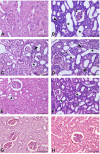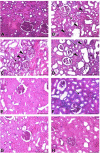Effect of flaxseed on systemic inflammation and oxidative stress in diabetic rats with or without chronic kidney disease
- PMID: 34665824
- PMCID: PMC8525749
- DOI: 10.1371/journal.pone.0258800
Effect of flaxseed on systemic inflammation and oxidative stress in diabetic rats with or without chronic kidney disease
Abstract
Background: Diabetes mellitus (DM) and chronic kidney disease (CKD) are common causes of morbidity and mortality. Flaxseed contains several bioactive compounds that have been shown to possess anti-inflammatory and antioxidative properties. The aim of the present study was to investigate the possible effect of flaxseed in diabetic rats with adenine-induced CKD.
Methods: Male Wister rats (n = 48) were randomly divided into seven equal groups and treated for 33 consecutive days as follows: G1: control. G2 adenine, G3: streptozotocin (STZ), G4: flaxseed, G5: adenine+flaxseed, G6: STZ+flaxseed, G7: adenine+STZ+flaxseed). DM or CKD were experimentally induced by a single intraperitoneal injection of streptozotocin (STZ) or by adenine via oral gavage, respectively.
Results: Rats fed adenine alone exhibited several changes including decreased body weight, increased food and water intake and urine output, increased urinary albumin/creatinine ratio. They also showed an increase in plasma urea and, creatinine, indoxyl sulfate, neutrophil gelatinase-associated lipocalin and cystatin C, and a decrease in renalase activity. These were associated with significant changes in inflammatory and oxidative biomarkers, e.g., increase in 8-isoprostane, 8 -hydroxy -2-deoxy guanosine and decrease in antioxidant enzymes, as well as increase in interleukins 1β and 6, and NF-κB, and a decrease in interlukin-10. Histopathologically, there was increased tubular necrosis and fibrosis. Concomitant administration of adenine and STZ further worsened the renal damage induced by adenine alone. Flaxseed significantly ameliorated the changes caused by adenine and STZ, given either singly or in combination.
Conclusion: These findings suggest that flaxseed is a potential therapeutic agent in attenuating the progression of CKD in diabetes.
Conflict of interest statement
The authors have declared that no competing interests exist.
Figures





References
-
- Saeedi P, Petersohn I, Salpea P, Malanda B, Karuranga S, Unwin N, et al.. Global and regional diabetes prevalence estimates for 2019 and projections for 2030 and 2045: Results from the International Diabetes Federation Diabetes Atlas, 9(th) edition. Diabetes Res Clin Pract. 2019;157:107843. doi: 10.1016/j.diabres.2019.107843 - DOI - PubMed
